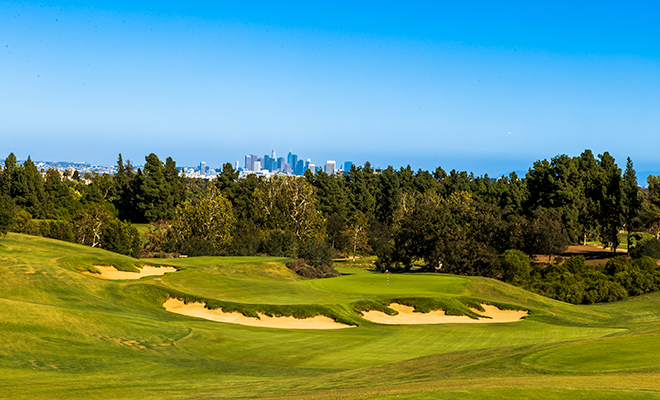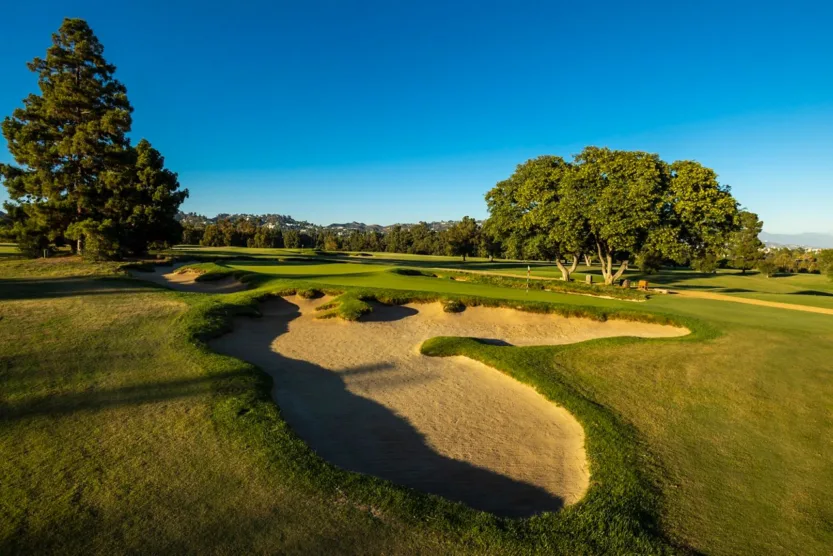The year was 1927, and golf architect George Thomas had just finished building one of his three indisputable Los Angeles golf masterpieces, the North Course at L.A. Country Club. (The others are Bel-Air and Riviera.)
Years later, actor, celebrity and party boy Howard Hughes would try to land his private airplane on the one of its fairways, only to miss and crash into a nearby house.
That’s how wide the fairways appear and LACC's North. Max Homa, holder of the course record, a jaw-dropping 9-under 61, called it a second-shot golf course and hinted you can drive a little wildly here and still have a chance to recover. Most of the rest of the field disagreed, citing that the cant of the fairways and dry, fast, firm conditions will send balls scurrying into the rough.
“They are much smaller than they appear,” remarked Jon Rahm of Spain, the 2021 U.S. Open champion. “That [61] won’t be happening again.”
Rahm is probably right; the Pac-12 championship is set up light-years more easily than the U.S. Open and now the Bermuda rough is thick and deep. And with greens approaching 14 on the stimpmeter, the Barranca weaving around the course dangerously, and ferociously contoured greens, players will be grinding on every shot, as any misstep can lead to double bogey or worse.
Let’s take a look at some of the most interesting and perplexing holes at Los Angeles Country Club’s North Course
Hole 1 (590 yards, par 5) and Hole 2 (498 yards, par 4)
George Thomas liked to open his golf courses with an easy par-5 followed by a long and difficult par-4, and LACC North is no exception. Like Riviera, the opening hole is a shortish, straight-away par-5 that should have the players licking their chops at the thought of opening the National Championship with a birdie. There are two mistakes to avoid: the deep front bunker and the greens runs away from the player, so don’t airmail the flagstick.
However, the second hole flips the script. The barranca, LACC North’s defining architectural feature, makes its first appearance, cutting in front of the green on this long, gently bending par 4, and the tee shot must be both long and precise to offer a good look at the green.

Holes 4-7
LACC North’s par 3s are a microcosm of the entire golf course. Some are short, but treacherous; some are long but playable and eminently fair.
The 228-yard par-3 third is completely encircled by trouble, whether it be sand, rough or a dry wash area peppered with uneven lies and bare spots. Likewise, the seventh is also ludicrously long par 3 of 284 yards, one of the longest in Open history, but still shorter than the 300-yard par-3 eighth at Oakmont in 2007 and 2016. Again, the Barranca cuts across the front of the green complex, placing a premium on both distance control and accuracy.
Sandwiched in between are two par 4s that are a study in contrasts. The 480-yard fifth is one of the tricky driving holes where the width of the fairway looks forgiving but in truth is anything but. Severely tilted from left to right, anything hit to the right side off the tee will end up in the thick Bermudagrass and will leave the golfer a blind approach shot.
No. 6, on the other hand is a mere 330 yards but presents the most tempting challenge: a chance to drive the green and putt for eagle. The risk, however, may not be worth the reward. Not only is the tee shot blind and played over tall trees when going for the green, but the green is completely surrounded by gunch, the Barranca and rough. Like No. 10 at Riviera, unless your tee shot is letter perfect, you’re begging for a par instead of carding a pushover birdie. The green is just a Lilliputian 12 paces front to back.

Holes 11 and 12
After birdie opportunities at the short par-5 eighth, par-3 ninth and short par-4 10th, another gargantuan par 3 appears: this time the reverse Redan at 11. A whopping 284 yards, at least the challenge sets up clearly in front of you.
At No. 12 however, the deception revives. This 380-yard par-4 seems tame on the scorecard, but the tee shot is not only blind but played between overhanging trees to, perhaps, the narrowest fairway on the golf course and severely canted. Hit it and hope it stays in the fairway. The approach is to a green smaller than the bunkers guarding it.

Holes 15-18
After a brutishly long par 4 at 13 and a 625-yard par-5 with a wild green that’s really three tiny greens in one, we reach the diminutive 15th, a par 3 that's normally just 124 yards but likely to be played at 78 yards one day, most likely Saturday. The green is the slenderest of slivers.
Starting at the 16th, it’s a long, tough run back to the clubhouse. No. 16 plays 542 yards and is one of the longest par 4s in US Open history. The only longer par 4s in U.S. Open history are:
- 551 yards, Chambers Bay, 13th hole, 2015
- 542 yards, Pinehurst No. 2, fourth hole, 2014
- 536 yards, Shinnecock Hills G.C., 14th hole, 2018
In a coup of routing – Thomas was a master – the stretch of 16-18 is the only run of holes on the golf course where there are three consecutive par 4s.
At No. 17, a 520-yard behemoth, the Barranca again threatens the tee shot on the right, while trees guard the left. Miss the green to the right, and you are playing your next shot from in in the Barranca well below the level of the green. The closing par 4 plays every bit of 492 yards home to the long, rambling white clubhouse. One deep bunker guards all of the front-left portion of the green while another bunker guards right.
With sparkling views of downtown, the ocean and beach and the mountains, L.A. Country Club’s North Course blends the best of other California Golden Age golf masterpieces, such as Olympic Club, Riviera, and even California Golf Club of San Francisco. The course boasts views of many iconic LA landmarks, including the Griffith Park Observatory, which can be seen from the Ronald Reagan Terrace in the clubhouse, as well as the Hollywood sign, Mt. Baldy and the downtown LA skyline.
Tucked between Century City, Beverly Hills and Westwood, the club is an oasis amidst the traffic of the world, and the concrete and steel of the skyscrapers metaphorically feel miles away while you are playing the golf course, even though you play in their shadow the entire day. With such a successful restoration, such glorious terrain, and an incomparable setting, LACC will like see more major championships in its future. All golf and all golfers will be better for it.

